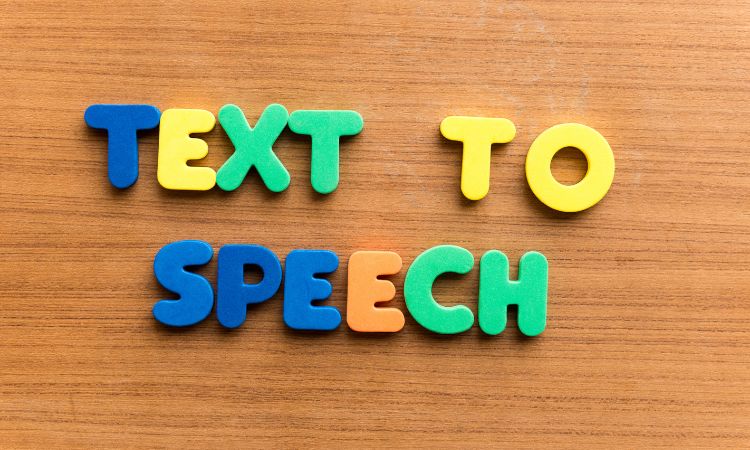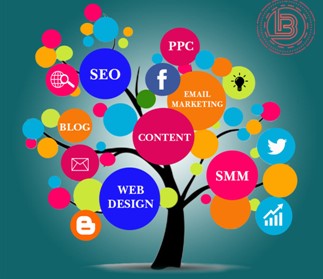In today's digital age, having a strong online presence is crucial for businesses to succeed.…

The Benefits of Using Text-to-Speech in Accessibility Solutions
In today’s digitally driven world, accessibility in technology is not just a moral imperative but also a legal requirement in many countries. It ensures that everyone, regardless of their abilities, can access and interact with digital content, services, and products. One technology that has significantly contributed to improving accessibility is Text-to-Speech (TTS). The global text-to-speech market size reached approximately USD 3.48 billion in 2023. The market is assessed to grow at a CAGR of 15.3% between 2024 and 2032 to attain a value of around USD 12.53 billion by 2032.
In this blog post, we will delve into the world of accessibility and explore how Text-to-Speech technology plays a pivotal role in making digital content more inclusive and accessible to individuals with disabilities. We will discuss the fundamentals of TTS, its applications, and, most importantly, the numerous benefits it offers in the realm of accessibility.
Understanding Accessibility and Its Challenges
Before we delve into the benefits of Text-to-Speech, it’s crucial to understand what accessibility means and the challenges faced by individuals with disabilities when using digital content.
Defining Accessibility
Accessibility, in the context of technology, refers to the design and development of digital products, services, and content that can be easily accessed and used by individuals with disabilities. It encompasses a wide range of disabilities, including visual, auditory, motor, and cognitive impairments.
The goal of accessibility is to ensure that no one is excluded from the digital world, regardless of their abilities. It is not just a matter of convenience but also a matter of basic human rights and inclusivity.
The Significance of Accessibility
Accessibility in technology is significant for several reasons:
- Legal and Ethical Requirements: Many countries have enacted laws and regulations that require digital content and services to be accessible. Failure to comply with these laws can result in legal penalties and damage to a company’s reputation.
- Market Expansion: By making products and services accessible, businesses can tap into a larger market that includes individuals with disabilities and elderly users who may have unique needs.
- Inclusivity: Ensuring accessibility is a matter of inclusivity and social responsibility. It allows individuals with disabilities to participate fully in education, employment, and social activities.
Challenges Faced by Individuals with Disabilities
People with disabilities encounter numerous challenges when using digital content and technology. Some of the common challenges include:
- Visual Impairments: Individuals who are blind or have low vision struggle to read text, view images, and navigate digital interfaces.
- Hearing Impairments: Deaf or hard-of-hearing individuals face difficulties accessing audio content and participating in video conferences.
- Motor Impairments: People with limited mobility or dexterity may find it challenging to use a traditional keyboard or mouse.
- Cognitive Impairments: Those with cognitive disabilities, such as dyslexia or attention deficit disorders, may struggle with complex and cluttered interfaces.
- Speech and Communication Disabilities: People with speech impairments may have difficulty communicating through traditional means.
How Text-to-Speech Technology Works
Now that we have a better understanding of accessibility and its challenges, let’s explore how Text-to-Speech (TTS) technology works and how it can address some of these challenges.
The Basics of TTS
Text-to-Speech technology, as the name suggests, converts text into spoken language. It operates on a simple yet powerful principle: transforming written words into audible speech.
The process involves three primary components:
- Text Analysis: The TTS system analyzes the input text to identify words, sentences, punctuation, and other linguistic elements.
- Text-to-Speech Synthesis: Using various algorithms and linguistic rules, the TTS system generates a corresponding speech waveform based on the analyzed text.
- Audio Output: The synthesized speech is played back through speakers or headphones, making it audible to the user.
The Importance of Naturalness
One of the key objectives in TTS development is to create natural-sounding speech. Naturalness ensures that the synthesized voice is not robotic or monotone but instead mimics human speech patterns, intonation, and pronunciation. This level of naturalness is crucial for a pleasant and comprehensible user experience.
Examples of TTS Applications and Devices
Text-to-Speech technology is integrated into a wide range of applications and devices to enhance accessibility and user experience. Here are some common examples:
1. Screen Readers
Screen readers are software applications that read aloud the content displayed on a computer screen. They are essential for individuals with visual impairments and enable them to navigate websites, read documents, and interact with software.
2. E-Books and Audiobooks
TTS is often used to create accessible versions of e-books and audiobooks. Users can listen to the content rather than relying on traditional reading, making it accessible to those with reading disabilities or visual impairments.
3. Navigation Systems
Navigation systems in cars, smartphones, and GPS devices utilize TTS to provide turn-by-turn directions and other location-based information audibly. This benefits drivers who need to keep their eyes on the road.
4. Assistive Communication Devices
TTS is integrated into augmentative and alternative communication (AAC) devices, helping individuals with speech and communication disabilities express themselves.
5. Voice Assistants
Voice-activated virtual assistants like Siri, Alexa, and Google Assistant use TTS to respond to user queries and provide information verbally. This technology has become ubiquitous in smart homes and mobile devices.
Now that we have a solid understanding of how Text-to-Speech technology functions and where it is applied, let’s delve into the benefits it offers in the realm of accessibility.
Benefits of Text-to-Speech in Accessibility
Text-to-Speech technology offers a plethora of benefits when it comes to accessibility. It has the power to transform the digital landscape and make it more inclusive for individuals with disabilities. Here are some of the key advantages:
1. Improved Web Accessibility
The internet is a fundamental part of our lives, but many websites and web applications are not designed with accessibility in mind. This can create barriers for individuals with disabilities who rely on screen readers and other assistive technologies.
Text-to-Speech technology helps bridge this gap by providing an audible representation of web content. Here’s how TTS improves web accessibility:
a. Screen Reader Compatibility
Screen readers, as mentioned earlier, rely on TTS to convert web content into speech. When websites are designed with proper accessibility practices, screen readers can effectively navigate and present the content to users with visual impairments.
b. Access to Visual Content
TTS allows users to “hear” visual elements of a webpage, such as images, charts, and graphs, through image descriptions or alt text. This ensures that individuals with visual impairments do not miss out on crucial information.
c. Enhanced Navigation
Web navigation menus, buttons, and links can be challenging to navigate for users with motor impairments. TTS can audibly guide users through menus and help them make selections, improving the overall user experience.
d. Accessible Forms and Documents
Forms and documents on websites often pose accessibility challenges. TTS can read form fields, labels, and document content, enabling users to interact with online forms and access document information.
2. Accessible E-Books and Documents
The digitalization of books and documents has opened up new possibilities for reading. However, individuals with print disabilities, such as blindness or dyslexia, may struggle with traditional printed materials. TTS technology offers the following benefits in this context:
a. Audiobook Accessibility
TTS can transform written content, including textbooks and novels, into audiobooks. This allows individuals with visual impairments or reading difficulties to access a wide range of literature.
b. Customizable Reading Experience
TTS allows users to customize the reading experience. They can adjust the speed of speech, choose preferred voices, and even highlight text as it’s read aloud. This level of customization caters to individual preferences and needs.
c. Multimodal Learning
In educational settings, TTS technology supports multimodal learning by combining auditory and visual elements. This can enhance comprehension and retention for all students, including those with learning disabilities.
3. Navigation and Information Access
People with visual impairments or cognitive disabilities often struggle with wayfinding and accessing information in physical spaces. TTS technology extends its benefits to real-world scenarios:
a. Public Transportation
Public transportation systems can utilize TTS to announce stops, routes, and service updates audibly. This assists individuals with visual or cognitive impairments in using public transportation independently.
b. Museums and Exhibits
In museums and exhibits, TTS can provide audio descriptions of artworks, artifacts, and displays. This allows visitors with visual impairments to engage with the exhibits on an equal footing with others.
c. Information Kiosks
TTS-equipped information kiosks in public places, such as airports and shopping malls, can provide essential information, directions, and updates audibly, ensuring that everyone can access the information they need.
4. Inclusive Communication
Inclusive communication is essential to ensure that individuals with speech and language disabilities can express themselves effectively. TTS technology facilitates inclusive communication in various ways:
a. Alternative Communication
TTS is integrated into augmentative and alternative communication (AAC) devices, which assist individuals with speech and language disabilities in expressing their thoughts and needs.
b. Voice Banking
Individuals facing the possibility of losing their voice due to medical conditions can use TTS technology to “bank” their own voices. This enables them to continue using their own voice, even if they lose the ability to speak.
5. Assistive Technology Integration
TTS is a cornerstone of assistive technology solutions. These technologies are designed to assist individuals with disabilities in performing tasks and accessing information. TTS is integrated into various assistive devices and software, including:
a. Communication Devices
Communication devices for individuals with speech and language disabilities rely on TTS to convert typed or selected messages into spoken words.
b. Braille Displays
TTS technology is integrated into refreshable Braille displays, providing an accessible method for blind individuals to access digital content in Braille format.
c. Screen Magnifiers
Individuals with low vision can benefit from screen magnifiers with TTS capabilities, which enlarge and read aloud on-screen content.
d. Voice Recognition Software
TTS is sometimes used in conjunction with voice recognition software to provide real-time feedback and enhance the user experience for individuals with mobility impairments.
6. Voice Assistants
Voice-activated virtual assistants like Siri, Alexa, and Google Assistant have become an integral part of our daily lives. These AI-driven technologies rely on TTS to respond to user queries and provide information verbally. This not only enhances convenience but also makes technology more accessible to individuals with disabilities.
In summary, Text-to-Speech technology plays a pivotal role in improving accessibility across various domains. It bridges the gap between digital content and individuals with disabilities, making it easier for them to access information, communicate, and participate in a digital society. In the next section, we will explore real-life success stories and examples of organizations and individuals who have benefited from TTS solutions.
Read More Articles
auto parts manufacturing companies
Real-Life Success Stories
To illustrate the profound impact of Text-to-Speech technology on accessibility, let’s explore some real-life success stories from organizations and individuals who have embraced TTS solutions.
Case Study 1: National Federation of the Blind (NFB)
The National Federation of the Blind (NFB), a prominent advocacy organization for the blind and visually impaired, has been a strong proponent of accessible technology. NFB’s commitment to accessibility led to the development of the NFB-NEWSLINE®, a service that provides blind individuals with access to newspapers and magazines.
NFB-NEWSLINE® utilizes TTS technology to deliver news content in an accessible format. Subscribers can listen to articles using TTS-enabled devices, ensuring that they stay informed about current events and news from around the world. This service has empowered blind individuals to access information independently, breaking down barriers to education, employment, and social participation.
Case Study 2: Bookshare
Bookshare is an innovative digital library that offers accessible e-books to individuals with print disabilities. The library includes a vast collection of titles, including textbooks, novels, and reference materials. TTS technology is at the core of Bookshare’s accessibility efforts.
Users of Bookshare can access books in various formats, including audiobooks generated using TTS. This means that individuals with visual impairments, dyslexia, or other reading disabilities can enjoy the same books as their peers, leveling the playing field in education and leisure reading.
Case Study 3: Voiceitt
Voiceitt is a groundbreaking startup that has harnessed the power of TTS to empower individuals with speech and language disorders. The company has developed an innovative speech recognition and translation platform that understands and translates non-standard speech patterns into clear and understandable speech.
Voiceitt’s technology allows individuals with conditions like cerebral palsy, stroke, or ALS to communicate effectively, improving their quality of life and fostering independence. It’s a remarkable example of how TTS can transform lives.
These real-life success stories highlight the tangible benefits that Text-to-Speech technology brings to individuals and organizations. It not only enhances accessibility but also fosters inclusion and independence.




This Post Has 0 Comments